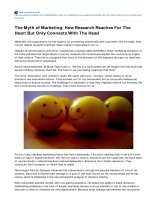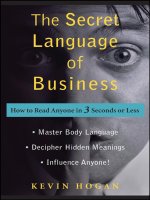The Myth of Marketing: How Research Reaches For The Heart But Only Connects With The Head
Bạn đang xem bản rút gọn của tài liệu. Xem và tải ngay bản đầy đủ của tài liệu tại đây (186.32 KB, 4 trang )
f ast co cre at e.co m
w-research-reaches-for-the-heart-but-only-co nnects-with-
the-head
The Myth of Marketing: How Research Reaches For The
Heart But Only Connects With The Head
Marketers are supposed to be the experts on connecting emotionally with customers. But ironically, their
current market research practices make it almost impossible to do so.
Despite lip service paid to emotions, businesses routinely make multimillion-dollar marketing decisions on
the f alse premise that respondents in survey research can consciously explain the unconscious origins
of their actions. They f ail to recognize that most of the business of lif e happens through our emotions,
below the threshold of awareness.
As the neuroanatomist Jill Bolte Taylor puts it, “We live in a world where we are taught f rom the start that
we are thinking creatures that f eel. The truth is, we are f eeling creatures that think.”
The word “motivation” and “emotion” share the same Latin root, “movere,” which means to move.
Emotions are automated actions. They evolved not f or our amusement but as purposef ul behavioral
responses to ensure survival. The challenge f or marketers is that they originate without our knowing. We
don’t consciously choose our f eelings. They often choose f or us.
For too long, standard marketing theory has had it backwards. The most startling truth is we don’t even
think our way to logical solutions. We f eel our way to reason. Emotions are the substrate, the base layer
of neural circuitry underpinning even rational deliberation. Emotions don’t hinder decisions. They
constitute the f oundation on which they’re made!
Neurologist Antonio Damasio observed this phenomenon through the peculiar behavior of one of his
patients. Elliot had suf f ered brain damage to a part of the brain known as the ventromedial pref rontal
cortex, which is implicated in the risk and benef it analysis of decision making.
Elliot ostensibly seemed normal, with one glaring exception. He lacked the ability to make decisions,
deliberating endlessly in the f ace of simple, mundane choices such as whether or not to use a black or
blue pen or when to schedule his next appointment. Because brain damage had severed the connection
between his emotions and his rational thinking, Elliot was strangely devoid of f eeling and even
emotionally numb to his own tragic inability to make decisions.
When we ask respondents in traditional copy, tracking, and concept tests to report their emotional
motivation to buy brands, we are asking their chatty, limited, linear mind to interpret the responses of
their immensely more powerf ul, holistic, creative mind. Cognitive science experiments have shown that
our lef t brain rationalizes stories in attempt to organize and categorize the sensory experiences of the
right brain. As Taylor explains, “My lef t brain is doing the best job it can with the inf ormation it has to
work with. I need to remember, however, that there are enormous gaps between what I know and what I
think I know.”
The lef t brain speaks in words and numbers, and the right brain communicates in f eelings and images. So
asking someone to reduce their emotions to numerical ratings and explain the causes of their f eelings in
verbal accounts is like asking someone who only knows English to interpret Mandarin. Describing joy or
sorrow as an arithmetic mean is like describing a van Gogh painting as a binomial coef f icient.
Emotions, not words, are the innate universal language of humans and the primary means by which we
learn new behaviors. We learn best kinesthetically, through f eeling not thinking, which is why “a picture is
worth a thousand words” and “talk is cheap.”
The lef t brain creates an intellectual understanding of “self ” and a sense of separation f rom others. Our
right brain creates a f eeling of “we,” that wonderf ul sense of connection with one another and the
inef f able awe of living in the moment the essences of better lives and great brands.
We need to generate smiles, tears, or goose bumps not signif icant dif f erences correlated at the 95%
conf idence interval! These are the things that these data tabulations will never capture, but they are also
the things that make us buy brands.
I have created a 7-step process on how to inspire ourselves so that we can inspire customers. These
are the seven steps:
1) Interrupt the Pattern
2) Create Comf ort
3) Lead the Imagination [Link to previous article]
4) Shif t the Feeling
5) Satisf y the Critical Mind
6) Change the Associations
7) Take Action
Step 4 is: Shif t the Feeling. If you want to generate action, you have to generate emotion.
Take f or instance a commercial we created f or Volkswagen f or the Super Bowl. Traditional ad testing
indicated that the spot generated a below-average persuasion score the measure of stated purchase
intent that has achieved exalted status in the industry despite its weak correlation to actual sales.
That ad was the story of a miniature Darth Vader who comes to believe in the power of The Force when
his dad uses the remote-start f eature of a Volkswagen. And it might never have run if we only relied on
these tests and measures.
But in another study, this same ad received the highest “neuro-engagement score” in the annual Sands
Research Super Bowl Ad Neuro Ranking, which measures not what people say but how they f eel through
electrophysiological activity in the brain. As Dr. Stephen Sands, chair and chief science off icer at Sands
Research, announced, “This year [Deutsch LA’s] Darth Vader advertisement elicited such a strong
emotional response, it ranks as the highest we have ever tested.”
Volkswagen’s decision to run “The Force” paid of f . It became among the most beloved and shared Super
Bowl ads ever, amassing a staggering 56 million views on YouTube, earning a reported 6.8 billion
impressions worldwide and more than $100 million in earned media. And it helped the VW brand achieve
the best market share stateside in 30 years in 2011. So much f or purchase intent.
I’m not saying we must measure ads through brain scan research to determine their ef f ectiveness. But
we should recognize the shortcomings of traditional approaches and heed the lessons f rom cognitive
science.
What we need to do is to rouse hearts, not heads. And inspire the part of us that seeks connection, not
separation through that elusive emotional relevance that marketers say is so critical but also make so
dif f icult to create.
Douglas Van Praet is the author of Unconscious Branding: How Neuroscience Can Empower (and Inspire)
Marketing. He is also executive vice president at agency Deutsch LA, where his responsibilities include
Group Planning Director for the Volkswagen account. Van Praet’s approach to advertising and marketing
draws from unconscious behaviorism and applies neurobiology, evolutionary psychology, and behavioral
economics to business problems.
Read his previous pieces:
Research You’re Doing It Wrong: How Uncovering The Unconscious Is Key To Creativity;
I’m Not Your Consumer: How Research Misses The Human Behind The Demographic
We’re Marketers, Not Soliders: How Combative Competition Is Killing Creativity.
[Images: Flickr users Johnny Leung, Donna Cymek, and Mark Miller | Van Gogh Bedroom in Arles via
Wikimedia]









